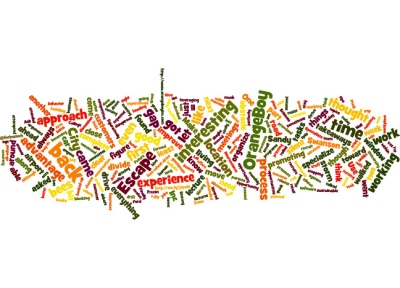By: Nickie Harber-Frankart
We’re constantly looking for innovative ways translate data and information into interesting visualizations for our clients. There are many ways to accomplish this by using bar charts, gauges and graphs, but but I’ve recently found word clouds to be incredibly useful for analyzing text.
Wordle.net provides text-based visualizations, using content pasted from articles, blogs, questions from surveys and more, making the top, most prominently used words in the text the largest in the cloud.
For fun, I entered the URL of our blog into Wordle.

The prominent words were: interesting, experience, customer, approach, OrangeBoy, work, time, meetings, process, and so on—all of which explain our mission to help our clients become customer-centric organizations.
This exercise was a reminder about branding and creating effective messaging. It was also a lesson in content analytics.
- Messaging should align with your target audience, as well as your organization’s mission, brand and personality. I was relieved to know that this was the case with our blog. However, it’s not uncommon to see misalignment. Often I hear clients say, I want our customers to know about XYZ, but it doesn’t align with customers’ needs or their behavior. Communication should relate to the core of what you do as an organization while meeting the needs of your customers. A good example is a library sending targeted email messages about early literacy programs to parents with small children who use the library.
- Use multiple visualizations to tell the whole story. The blog publisher WordPress has a dashboard tool that displays visitation statistics, views, clicks, and popular pages and topics. Amidst all of this “raw” usage data, there are no metrics to describe the blog’s personality or common message themes. The word cloud helped uncover that. By using Wordle, I was able to visualize the messages we send to our readers and understand commonly used words that describe our blog’s personality as it relates to our brand. In other words, multiple data visualizations resulted in a well-rounded story about messaging and its impact on behavior.
I encourage you to think about your messages and use analytics in a similar way. The next time you craft a message to your customers think about how it aligns with their needs and your organization’s brand and mission. Then, consider the best way to measure the impact of that message, effectively.
OrangeBoy works with organizations to uncover valuable insights about customers and the markets they serve. Insights lead to innovative solutions. OrangeBoy helps clients create personalized customer experiences and communications to achieve measurable results.
